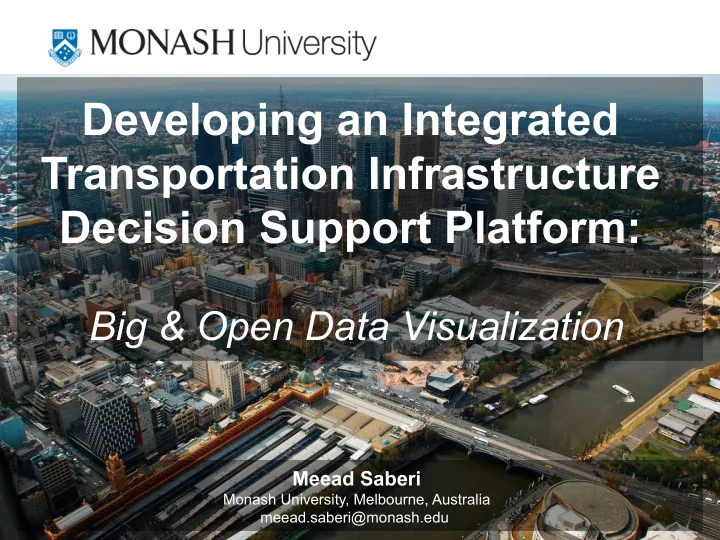

Engineering Developing an Integrated Transportation Infrastructure Decision Support Platform: Big & Open Data Visualization Meead Saberi Monash University, Melbourne, Australia meead.saberi@monash.edu
MEET THE TEAM Majid Sarvi (Civil Eng., Monash University) Meead Saberi (Civil Eng., Monash University) Terry Liu (Civil Eng., Monash University) Freider Seible (Civil Eng., Monash University) Colin Caprani (Civil Eng., Monash University) Jayantha Kodikara (Civil Eng., Monash University) Chris Rudiger (Civil Eng., Monash University) Omid Ejtemai (Civil Eng., Monash University) Mark Stevenson (MUARC, Monash University) Mehmet Yuce (Electrical Engineering, Monash University) Kim Marriott (Information Technology, Monash University) Russel Thompson (University of Melbourne) Abbas Rajabifard (University of Melbourne) Dr. Meead Saberi 2
What is a Decision Support System (DSS)? DSS is a computer-based system that supports decision-making; usually aimed at less well-structured and underspecified problems that upper level managers typically face. DSS attempts to combine the use of models and analytical techniques with traditional or advanced data access; focuses on features which make them easy to use by non-expert people in an interactive mode. Source: Sprague (1980) Dr. Meead Saberi 3
Fundamental Components of a DSS Database User Model Interface Dr. Meead Saberi 4
Current State-of-the-Art Existing transportation models/decision support systems are mostly disconnected. There is no fully integrated unifying tool for planning, operations, and management analyses. Current major focus is on integration of supply and demand models (e.g. ABM-DTA integration). Examples: POLARIS, MATSim, CMAP ABM-DTA integrated model, etc. Dr. Meead Saberi 5
Vision: Full Integration A fully integrated system goes beyond supply and demand models only. It integrates with real-time data , take advantage of big data and existing ICT technologies , and provide a fully connected modeling environment . Dr. Meead Saberi 6
Developing a fully integrated decision support platform @ITS MONASH, Australia Integrated understanding of multimodal traffic, land use, urban form, transportation planning needs, public health, safety, welfare, social interactions, demographics and communities. Dr. Meead Saberi 7
What’s special about our DSS? § Developing a unifying tool with operational, planning, and management applications in many areas. § Offline/online data integration , communication with a network of sensors , and utilization of advanced ICT technologies . § Applying advanced vizualisation , optimization and computational techniques to tackle issues of tomorrow’s transportation systems. § The goal is to assist in better management of complex integrated transportation and urban infrastructure systems in Victoria, Australia ( as a starting point ). Dr. Meead Saberi 8
Schematic Illustration of our DSS Dr. Meead Saberi 9
Real-Time Sensor Network Data Dr. Meead Saberi 10
Bushfire is a big issue in Australia. Australian National Bushfire Monitoring System http://sentinel.ga.gov.au/ A network of sensors (for fire detection) are developed to collect and transmit data to the platform wirelessly. Dr. Meead Saberi 11
Crowd-Sourced Data Dr. Meead Saberi 12
Mobile App: “Victoria Connect” • We’ve developed a mobile app which allows citizens to report various types of “ usually un-reported ” data. • Crowd-sourced data are combined with authoritative data. • Integrated data are visualized and shared publicly with citizens. • Integrated data are used in optimizing transportation network operations and planning. Dr. Meead Saberi 13
Cloud Data Integration § Developing an online integrated database in a government-funded cloud (NECTAR). (ongoing) § Developing online visualizations, accessing data from the cloud in real- time. (ongoing) § Cloud computing. (future) Dr. Meead Saberi 14
How does our database look like now? No user interface yet. We’re working on the back end. Dr. Meead Saberi 15
Network Simulation and Modeling Core § Developing a multimodal DTA model of Melbourne metropolitan area. (ongoing) § Auto-calibration using various traffic counts and travel time data sources. (ongoing) § Dynamic OD estimation. (ongoing) § Integration with an ABM. (future) Dr. Meead Saberi 16
Connected Modeling Environment § Crash frequency prediction (ongoing) § Network reliability and resilience; critical link identification (ongoing) § Land use model (future) § Public health model (future) § and many more … Dr. Meead Saberi 17
Interactive Visualization Dr. Meead Saberi 18
Visualizing Population Growth ¡ Dr. Meead Saberi 19
Visualizing Ethnicity Distribution ¡ Interested to see how Chicago and Washington D.C. look like? Washington D.C. http://4.bp.blogspot.com/-_6KwMlIWucI/U8CEx39ydAI/AAAAAAAAI3U/MDUydp7Zk1g/s1600/DC.png Chicago http://www.wired.com/images_blogs/design/2013/08/chicago.jpg Dr. Meead Saberi 20
Visualizing Age Distribution ¡ Dr. Meead Saberi 21
Visualizing Bicycles Crashes ¡ Dr. Meead Saberi 22
Visualizing Housing Density ¡ Dr. Meead Saberi 23
3D Immersive Visualization Dr. Meead Saberi 24
CAVE2 Dr. Meead Saberi 25
What do we get out of the DSS? Evaluation of current condition and prediction of future status of transport infrastructure system: § Evidence-based policy making § What if scenario analysis § Economic impact § Environmental impact, etc. Dr. Meead Saberi 26
A second look at the bigger picture Dr. Meead Saberi 27
Where we are today? We’ve already developed the backbone of the DSS. ü Wireless fire detection sensors are developed and tested. ü Mobile app is developed and tested. ü Cloud instance is set up. We’re developing the database. ü DTA model of Melbourne is being developed. ü A few data visualizations are developed. More are coming. ü The network display at CAVE2 is set up. Dr. Meead Saberi 28
Engineering QUESTIONS Meead Saberi meead.saberi@monash.edu
Recommend
More recommend